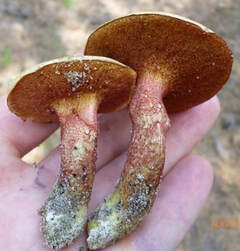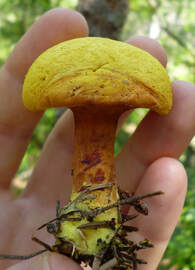RARELY RECORDED FUNGI
Yes, you may not being seeing things!
DISAPPEARING FUNGI
It is not uncommon for a species not to be seen for years and then reappear. A decline in rainfall matters. Around 90% of all land plant species engage in mutualistic relationships with fungi, which form mycorrhizas in their roots. So a decline in trees can also result in a decline in certain species of fungi.
Unlike Pennsylvania, NJ does not have a system to get fungi listed as rare. To get fungi recorded as rare, data must be collected. NJMA and online observational reporting databases are where data can be collected. So if you observe a rare fungi, leave it alone, but photograph it and record it on iNaturalist or Mushroom Observer.
NJMA Rarely Recorded Fungi
Resources
Last Updated 2023-10-06
It is not uncommon for a species not to be seen for years and then reappear. A decline in rainfall matters. Around 90% of all land plant species engage in mutualistic relationships with fungi, which form mycorrhizas in their roots. So a decline in trees can also result in a decline in certain species of fungi.
Unlike Pennsylvania, NJ does not have a system to get fungi listed as rare. To get fungi recorded as rare, data must be collected. NJMA and online observational reporting databases are where data can be collected. So if you observe a rare fungi, leave it alone, but photograph it and record it on iNaturalist or Mushroom Observer.
NJMA Rarely Recorded Fungi
- Tricholoma grave - Seen in November 2018. a large showy mushroom. Documented as Mushroom Observer 342735 and currently under assessment on the Global Fungal Red List for North America.
- Boletus purpureorubellus - Seen in October 2016 per NJMA News 46-6. Its first official NJ sighting was in the White Cedar swamps at Brendan Byrne State Forest
- Amanita scalaris - Seen in 2012 per NJMA News 43-1. Latest info at http://www.amanitaceae.org/ still indicates it has been seen only in two pine-oak areas in NJ damaged by off-road vehicles.
- Entoloma indigoferum (formerly Calliderma indigofera) - In the 1870"s J.B. Ellis, a mycologist of world renown, who lived in Newfield, N.J. collected a beautiful, blue mushroom with pink gills, growing with the Atlantic White Cedar near his home. He called it Entoloma indigoferum. Later the genus was changed to Calliderma. There seems to be confusion about what is the current name. Dr. Tim Baroni names it Calliderma on page 237 of Mushrooms of the Northeastern United States and Canada. It was not until July 2013 that it was recorded again on a NJMA foray. It has been found at that same location since then. In 2020, we found it in six more locations, always growing with Atlantic White Cedar. If you find this mushroom, please take photos and let NJMA know so we can keep tracking this rare mushroom. Dozens of sightings of this species can now be found on iNaturalist.
- Boletus weberi - Originally thought to be a Gulf Coast mushroom, DNA-confirmed specimens have been found in the New Jersey Pine Barrens.
- Buchwaldoboletus hemichrysus - A primitive not mycorrhizal species. DNA testing moved this mushroom into the newly erected genus “Buchwaldoboletus".
- Sarcodon atroviridis - Was found in the Franklin Parker Preserve (FPP).
- Little Brown Mushrooms (LBM) - Many are overlooked, and therefore not recorded.
Resources
- FundDiS Rare Northeast Rare Fungi Challenge - July 2022 - December 2027 - This challenge contains Tricholoma grave, which has seen in the late fall in the NJ pine barrens, and Echinodontium ballouii (Atlantic White-Cedar Conk) which was described from the NJ pine barrens but has not been recorded in NJ in over a century. It might be easier to find the latter in the winter when you can see up into the cedar trees.
- State of The World's Fungi
- Global Fungal Red List Initiative
- IUCN Red List of Threatened Species
- Mushroom Observer Rare Species
Last Updated 2023-10-06











